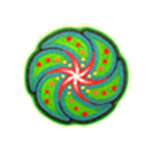The Huichol region sits on the ridge of the Sierra Madre Occidental, in the state of Nayarit Jaliscoy.

Culture and tradition of the Huichol
The Wixárika Indians, known today as Huichol inhabit the central western Mexico in the Sierra Madre Occidental primarily in the states of Jalisco, Nayarit, Zacatecas and Durango principalemnte. Wixarica or 'people' in their language called by linguists Wixaritari or vaniuki (known as Huichol language), which belongs to the family of languages Uto-Aztecan call themselves. The Huichol etnónimo was given by the Mexica in a derogatory manner to Wixarrikas before the Spanish Conquest.
The Wixaritaris speak a language cora-chol group is closely related to the Nahua group or aztecoide. They have also received Mesoamerican influences, which is reflected in the Huichol has typical features of Mesoamerican language area.
The Huichol region is based mainly on the spine of the Sierra Madre Occidental, in the state of Jalisco and Nayarit. Divided into five large communities, each of which is autonomous; It has its own civil and religious authorities. The civil authority is headed by a governor named totohuani and is renewed annually. The maraakates or -cantadores or maraakames priests are those who conserve and maintain the traditions alive.
The Wixaritari are notorious for their showy clothing. The Kamirra (kamixa - shirt) or kutuni, ie 'long shirt', open the sides and tied at the waist with juayame 'wide and thick belt' made of wool or yarn. Above the embroidered belt will several little bags called kuihuame or huaikuri, together with a cord. They do not save anything, serve only to complete the decoration. Cross shoulder carries one or more kuchuri or knapsacks or embroidered fabrics. On the back, the tubarra kind of embroidery kerchief, knotted around his neck and is on the edge a strip of red flannel. A hat they call rupurero (xupurexu - * šubureru - hat), made of palm and decorated in various ways according to use: with beads, feathers, yarn, flowers, thorns or pieces of bark. Man is always using the most decorated clothes.
Wife puts all his care for the clothes look very well embroidered. In contrast to the male attire, costume Huichol woman is simple: It consists of a short blouse to the waist, they call kutuni. Skirt waistband called ihui, carries on the bottom edge a wide swath of embroidery as well as the blouse. head covered with ricuri, consisting of two boxes beautifully embroidered white blanket also. Traditional decorative designs Huichol clothes are a huge variety and preserved since ancient times a magic meaning described the Norwegian anthropologist Carl Lumholtz, The Unknown Mexico in 1896.
For parties Huichol usually face painted with symbolic designs and ceremonial rituals maraakates use Muwieris 'plumed sticks' Their religion consists of four main deities: Corn, Eagles, Deer and Peyote, all are descendants of the Sun, "Tau". Their religious ceremonies are held in a mountain called Wirikuta or 'Burn', in the state of San Luis Potosi (Mexico). This mountain is divided into two, one side for women and one for men. In their religious ceremonies usually made use of peyote, here's an excerpt of what it means for them using this cactus:
Some people have some physical illness, soul or heart or just could not find our life. In this living and magical, end of the world, the Blue Deer desert reveal us to find our life, he taught us, he will be our medicine...
Maximization of the spirit will lead us to the point of temporary transformation in transition to spiritual exaltation, to find balance forces. That ineffable ability to venture without fear on the narrow bridge across the great gulf between the ordinary world of the world beyond. To achieve balance these forces must overcome our fears, to remove evil thoughts of our hearts and unite them. Pilgrims must be clean from all evil of feeling, we must return to the period of life when we were innocent, before we were adults, worldly, since this land come to birth mother. The pass from this world to the hereafter we can do, because when you get the Blue Deer, stop being ordinary, will be changed. But remember that it is only temporary because we are only men and women, not gods
It is worth mentioning that religion is implied through the life of the Huichol, it is part of its identity and is present throughout their actions, customs and daily life both individualente and the community. Religion becomes a fundamental commitment in its existence, it is part of its culture and its various forms of expression

